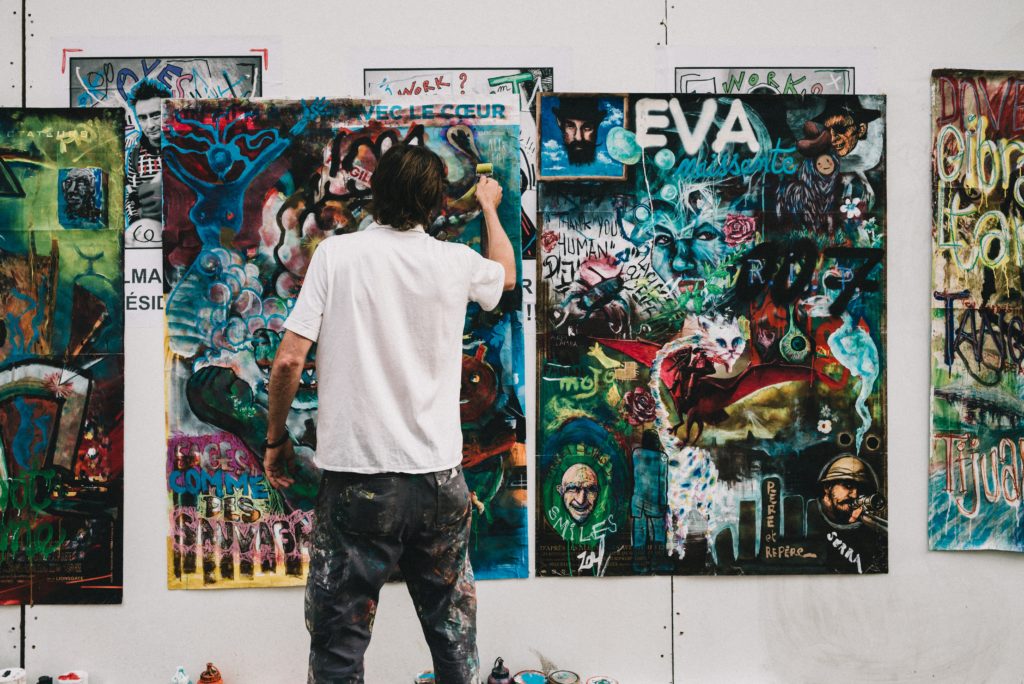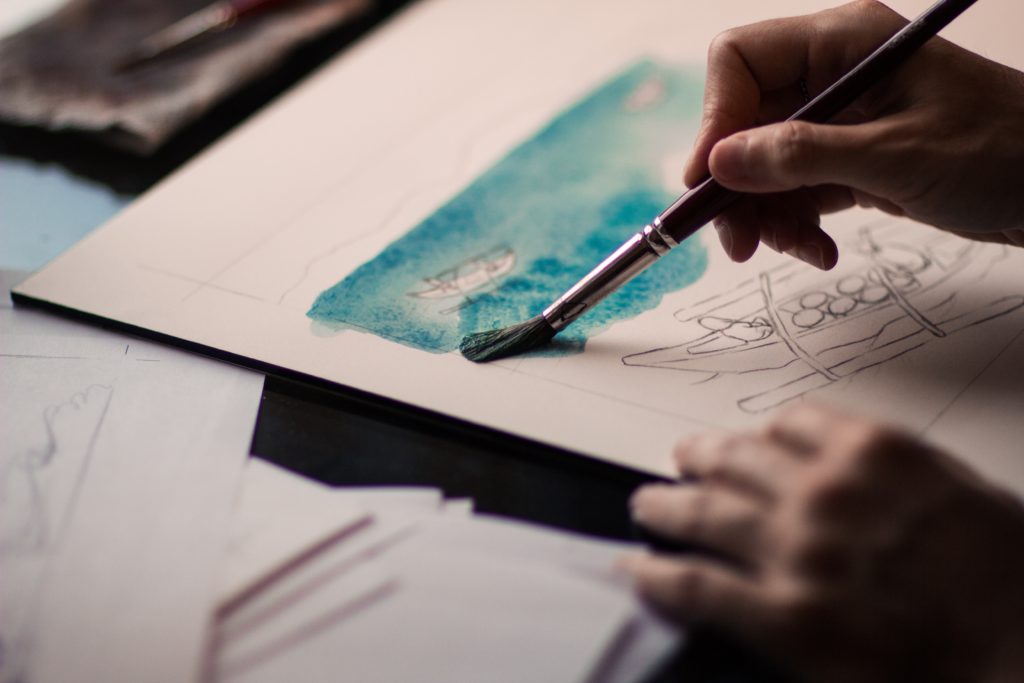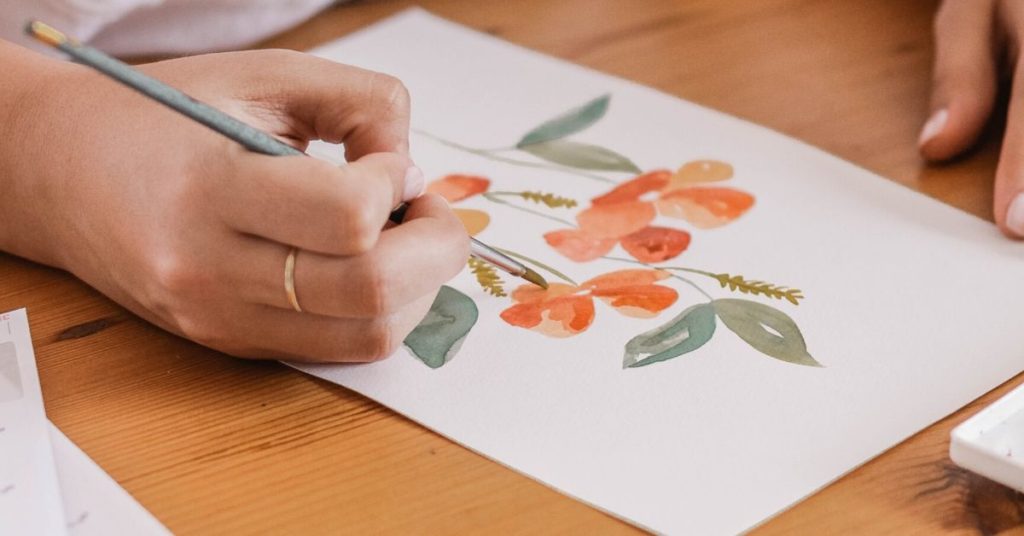Vincent van Gogh, Frida Kahlo, and Yoko Ono have one common denominator aside from being in the realm of the globally recognized artists of all time – and that’s they are all self-taught.
They are just three of the many other self-taught artists the world has known.
And they are proven testaments that one can be a successful artist without a formal education in the arts.
They were able to do it during their time when it’s much harder to showcase their portfolio and reach their target market.
So, you can definitely do it today! It may take some time, or it may be sooner, but you can get there.

In this article, I will impart some ways on how to be a successful self-taught artist.
I am also delighted to share some of my personal experience with the hope that it might fire a flicker of hope within your core – that you can study arts on your own and be successful in this competitive, yet rewarding industry.
Artist Tips: 10 Ways on How to Become an Artist
1. Start with a Positive Mindset
Let’s face it – we all start at the bottom. And that’s a good thing since it only goes to show that there is no other way for us to go but up.
You’ve got to always put that in mind whenever doubts start to creep into your senses. Don’t let negativities overpower you and keep you from reaching your goals.
If you are lost, or in need of some inspiration – just look around you or you can also start with these 14 podcasts that can help you spark your creativity.
2. Set Your Goals
Studying art on your own can be challenging. You don’t have deadlines to beat, and schedule to fit into. You are all by yourself. That is why if you don’t set some goals, you already set yourself to fail.
However, it is not enough to just write what you want to achieve within this week or a month. It is also equally important to stick with your game plan in reaching these goals no matter what.
This may be easier said than done, but that’s how it is. You’ve got to accept it and suck it up. And remember to keep your goals SMART: specific, measurable, attainable, realistic, and time-bound.
3. Watch Tutorials and Study from Books
Now that you have your goals written in black and white, it’s time to act on them. Without a doubt, the most convenient free way to learn a new skill today is by watching tutorials on YouTube.
There are several videos out there that talk about different skills from doing fashion illustration, caricature, pencil art, realist drawings, manga art, and so on.
You can begin with these 10 YouTube art channels.
It’s always a good thing to have several resources while you are honing your skills. As such, you can also make use of the public library in your area.
You can start reading about art history, or learn the fundamentals in drawing, painting, or whatever medium you’d like to begin with.
Being an artist, I know you also find solace in spending time in the arts section of a book store. Save some money and buy that art book that you’ve always wanted.
If you don’t have an author or artist in mind, yet, you can start with books by Andrew Loomis and George Bridgman.
Remember, every penny that you spend on self-improvement is worth it.
So, don’t hesitate. Go on and buy the book. Learn from it, and practice what you learned.
4. Practice and Fail Forward

A common mistake that is committed by anyone who wants to learn a new skill is the intention to read and watch as many books and tutorial videos as possible before trying out what they’ve learned.
Having the skill is crucial in becoming a successful artist, and it can’t be developed by only reading books and watching videos. You need to practice.
Don’t be afraid to commit mistakes and to fail. We learn through our failures, and in this field, we learn through implementation.
Moreover, it’s also important to be consistent with what you are doing. Considering that you also have a full-time job, or you are studying at school, it’s understandable that you can’t allot so much time to practice and hone your skills. However, this should not be an excuse for you to be inconsistent.
You don’t have to spend long hours every day to study, watch videos, and to practice. The key here is having focused and dedicated sessions every week.
And before practicing, don’t forget tip #2, which is to set your goal. In that way, you can be sure that you are putting in the hours going in the right direction.
For example, if your goal is to master fashion illustration, you can start in drawing each part of the human body separately and then progress to sketching a full figure following the 9-heads principle.
And before you proceed in adding colors to your drawing, you can first practice the proper shading techniques, while considering the different light sources.
You can do the two separate tasks that I mentioned in 2 sessions within 2 days. So, you don’t have to do everything in one sitting. It is more important that you are consistently doing something to achieve your goals.

5. Learn by Copying the Masters
If you want to be great, then you’ve got to do what the great masters have done.
You don’t have to worry about infringing intellectual rights since you won’t be selling or publishing your artwork for commercial use. You are just using their artwork as a model, so you won’t exhaust your creative energy into thinking an original concept just for the sake of practicing what you’ve learned.
Of course, you have all the time that you need in creating your original artwork later. You don’t have to rush things. As they say, there’s always time for everything.

The primary goal of copying the techniques and processes of the masters is for you to have a better understanding of how they work.
In doing so, you will learn what problems they faced along the way, and you will also realize why they chose certain colors and strokes over the other options.
And as you continue discovering these details, you will be able to incorporate or disregard their techniques as you develop your style. Trust me when I say that in the arts, you learn as you go along.
6. Keep Your Eyes on the Prize
It is so easy to be distracted if you are on your own and if you have the liberty to do whatever you want to do with your time.
As such, your ability to focus on your goals plays a pivotal role in your success as a self-taught artist.
The knack to stay focused on your task lies at the core of the concept of mind over matter.
Hence, you’ve got to condition your mind to do and finish a certain task within a specific time. Sit, relax, do some deep breathing exercises and focus your energy on what you are doing. With practice, it will be easier for you to stay focused.
7. Keep Track of Your Progress
There are several reasons why you need to keep track of everything that you do other than sentimental reasons.
Apparently, you can monitor your progress by comparing your artwork as time passes by.
As you learn more techniques and harness your skills, it will also reflect on your current works.
And if you don’t have a reference to compare, you’ll never know how far you’ve come as far as your skills are concerned.
Believe me when I say that you will arrive at a point that you will be surprised to see how you have improved through the years.
You may also look at your previous artworks and laugh at how ridiculous they are, and you may even ask yourself if it’s really yours.
When that moment comes, you’ll just be thankful that you were able to keep your old drawings, and artworks.
You won’t realize the value of such a priceless moment until you experience it by yourself.
You can even record yourself once in a while, and months or years after, you can look at the video and observe some changes in the way you do your artwork.
This time, it’s not just an old artwork of yours, but an old video of you while drawing, or painting something.
And of course, you can make use of social media to have visual documentation of your progress.
This way, you are also eliciting a response from your audience as you post. They might give you feedback, or they might just hit the like button, but at least your artwork is just on your profile readily available.
Every time you open your account, especially on Instagram, you can easily see your old artworks in one central location.
8. Connect With Other Artists
If there is one major disadvantage of not going to an art school, it would be not having the chance to join in a school organization for artists just like you.
Nevertheless, you can always join other art groups in your area. And there are several ways by which you can connect with other artists.
To some extent, we can think of self-taught artists as home-based artists. As such, to break the monotony of your environment as far as your artistic ventures are concerned, you can immerse yourself to the artistic community around you.
Join art competitions, art classes, exhibitions, conferences, talks, art demonstrations, and online artwork communities like DeviantArt.
You can also volunteer as an intern at an art shop or a painter’s studio in your area.
They might or they might not pay you, but you’ll gain valuable insights and priceless experience that can help you in your journey as a self-taught artist.
9. Market Yourself and Your Services
Your amazing portfolio won’t make a difference if nobody knows you, and no one has seen your works.
Hence, you must make use of our technological advantage compared to the artists in the old days.
Share your art through different social media platforms. You can start with Instagram, Facebook, Pinterest, Tumblr, and Twitter.
Make your own website. You can showcase your talent and skills more professionally if you have a website.
Believe me or not, people will hire you or buy from you not just because you are talented, but because you are more professional than the rest.
And investing in a well-designed and user-friendly website can make all the difference!
Creating and managing your website doesn’t cost that much! Check out this guide about the best website builders and packages available for artists.
10. Get a Part-time or Full-time Job

As they say, “experience is the best teacher.” Hence, if you are planning to have a lucrative career as an artist, you should dip your foot and test the waters.
Don’t wait for the perfect time. Don’t wait when you are ready, because that time never comes. If you’ll resort to that mentality, then chances are, a year or two after, you’ll just look back and realize how much time you’ve wasted in waiting.
Another common mistake made by most artists is that they wait for the opportunity to come.
They wait for famous artists to notice their works and offer them a job. You’ve got to get out of your self-made fantasy world. It doesn’t work that way.
So, go out, find a part-time or full-time job as an artist. You’ve got to experience the pressure of meeting deadlines and of hearing your client’s criticisms.
You’ve got to experience how it feels to live and hustle in the real work as an artist. Let go of the “I’m still young,” mentality. Success comes to anyone regardless of age and years of experience.
How to Study Art on Your Own
There is no single formula on how to become an artist, and the ten ways that were enumerated above are good starting points if you are still lost on where and how to study art on your own.
Well, of course, you can outline your steps and ask the expert advice of well-established artists. Whether they are self-taught or not, they surely have some tricks of the trade, words of wisdom and valuable insights to share that you can learn from.
Artist Tips: Self-taught Artist Resources
Like what was mentioned earlier, YouTube is the biggest social media platform where you can access free tutorial videos.
You can also share your works and progress there. But aside from YouTube, there are still several self-taught artist resources that you can run into such as the following:
Paint Your Path: Teach Yourself Art and Prepare to Succeed
You are an artist, so it’s given that you know how to paint your path towards the pedestal.
It might sound cliché, but you’ve got to believe in yourself and what you are capable of doing.
As a beginning self-taught artist, you may face a lot of insecurities and doubts, but just keep on doing what you love.
Today, there might only be a few people who admire your works. But, just keep moving. Keep stroking your brush and your pencil.
Do everything within your reach and capacity to make yourself better.
One day, you’ll wake up to a morning filled with so much love, admiration, and wealth – all because you believed in yourself when no one did.
Good luck and May the force be with you!
Feel free to share this article if you liked it and if you think your friends will. Also, don’t forget to leave a comment below. I’d love to hear your thoughts out.



